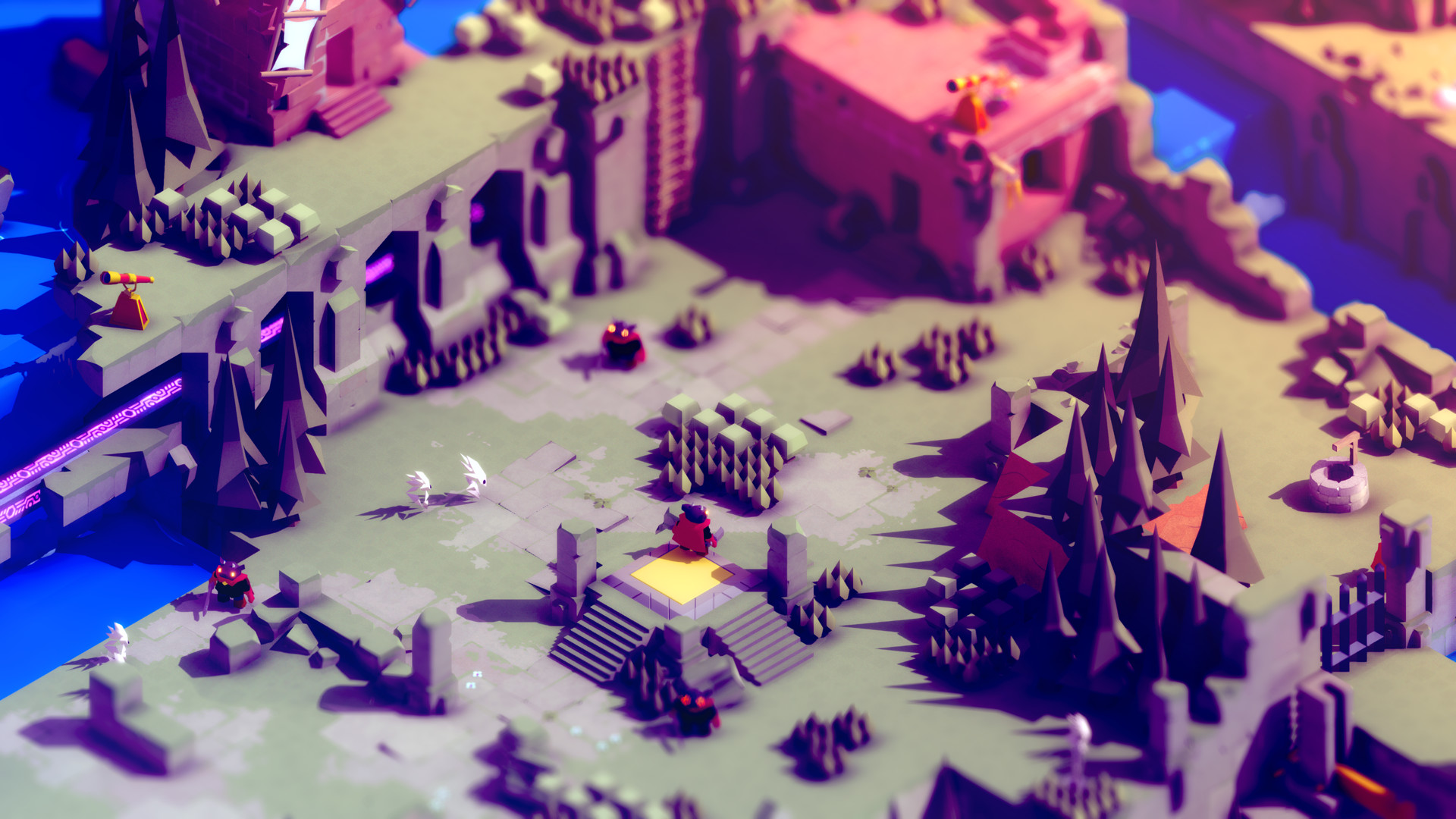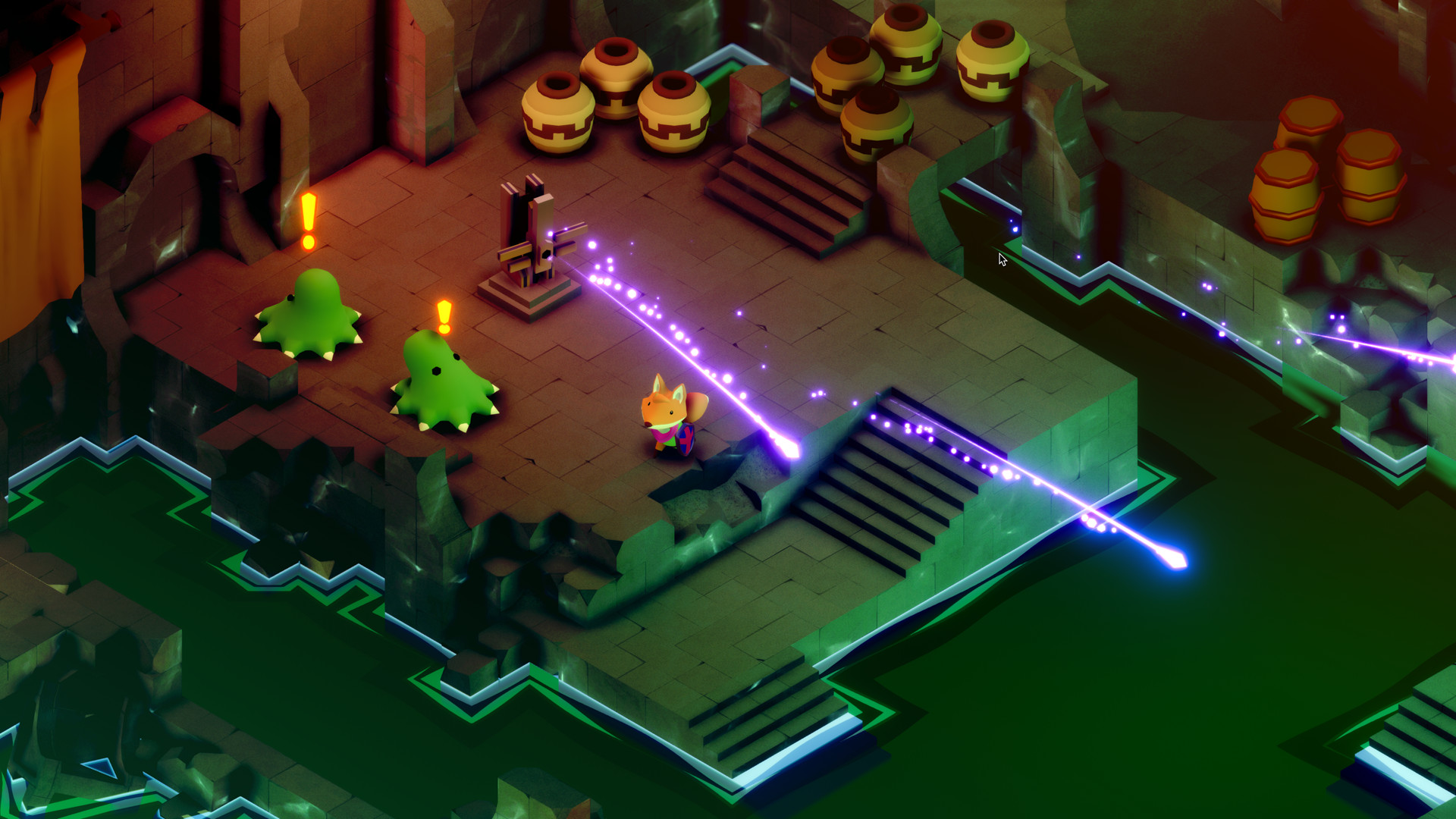
With a top-down perspective, approachable mechanics, and near-constant sense of discovery, you might think I’m talking about classics like Ys or Zelda when I describe Andrew Shouldice and Finji’s new game Tunic. But alas, you’d be wrong. In a sea of countless games that have tried and largely failed to strike the same oil those iconic classics did 30 some-odd years ago, Tunic gets closer than most. With almost immaculate execution and a delightfully whimsical art style, Tunic more than manages to stitch together its generously borrowed, tried-and-true elements while injecting more than enough of its own flavor into them to create a positively enchanting experience that feels much more original and inviting than it might seem like it would.
As you might expect with basically any isometric action-adventure such as this, there are a lot of the genre staples present. Starting off weak and working your way up with better weapons and abilities, fairly simple yet engaging combat, secrets to find, a history to uncover, and of course a bit of backtracking to areas that are only available to you after you’ve acquired the necessary means to access them later, etcetera. So, it’s got a lot of the basic parts that a game like this would generally have, but where Tunic really shines is in how it throws in generous helpings of its own special seasonings. The first flavor you’ll taste is of course the absolutely adorable visuals that combine simple low-poly designs with soft lighting and a shallow depth of field that come together with the best results that I’ve seen out of this style.
"With almost immaculate execution and a delightfully whimsical art style, Tunic more than manages to stitch together its generously borrowed, tried-and-true elements while injecting more than enough of its own flavor into them to create a positively enchanting experience that feels much more original and inviting than it might seem like it would."
The isometric viewpoint is rarely pulled off this well with indie games, as they can often cause unnecessary confusion and downplay a game’s artistic prowess, but this isn’t a problem for Tunic – which feels tailor-made for this sort of perspective. The diverse set of locations, fun enemy designs, and other little touches like bushes bouncing around like rubbery toys after chopping through them elevate the art style to truly great heights. It’s pretty clear that every element of Tunic’s visual and gameplay identity was lovingly and carefully modified to fit its very specific tone. I was often mesmerized upon entering a new location with how each area plays with light, shadows, and softness in different and interesting ways – further motivating me to make it to the next location to marvel at it before diving in.
At first, I thought I was playing a version of Tunic meant for a different region, as the gameplay text is… not English. But I quickly realized it’s not any real language. Tunic has a gameplay language that is purposefully unknown to you, yet still somehow manages to communicate effectively by triggering your instinct to fill in the gaps. When you find a key, a weapon, a potion, or anything else, you generally know exactly what it is and what it’s for – unless of course the game doesn’t want you to know yet. This is slightly undercut at times though. Certain signs and other things will use English text as well as the fictional language, and I really wish they had just leaned into the latter more consistently.
Still, this leads me to another one of Tunic’s excellent ideas; the discovery that you yourself go through as you play the game. The main character, the story, and general setting of Tunic is a mystery in and of itself. Our little fox seems to generally know what they’re doing, but you as the player do not know much at first. As you play through and uncover the world’s many secrets within the game, having little more than your most basic video game instincts to guide you, you also slowly peel back the curtain to reveal the story itself. Vagueness in a game’s story can be a double-edged blade, as it can be very intriguing, but not having any idea about what is going on can also easily zap the motivation to continue if the game doesn’t beckon you forward by other means. But like the few games that have managed to strike that balance, Tunic does it wonderfully.
"Vagueness in a game’s story can be a double-edged blade, as it can be very intriguing, but not having any idea about what is going on can also easily zap the motivation to continue if the game doesn’t beckon you forward by other means. But like the few games that have managed to strike that balance, Tunic does it wonderfully."
While a lot of this discovery is happening in your head, it’s also wisely illustrated to you as a full-color game manual (remember those?) that you slowly but steadily piece together and can refer to at any time. Despite the manual also being riddled with the game’s made-up language, it also, like the rest of the game, manages to communicate the game’s basic components just fine. It also should help bridge the gap for younger players that aren’t picking up on the cues, or just to brush up for anybody who returns to the game after a few months of something else. So, it’s just as useful as it is fun to flip around in. Ultimately the design strategy of letting you make your own logical assumptions about what is going on based on well-known fundamentals of this particular genre – and filling in those gaps with the realities of the actual game as it rolls along – is nothing short of genius. While it’s by no means a brand-new concept, it is handled extremely well here.
Unlike the story, you’re likely to pick up almost instantly on the combat. After assigning your favorite weapon to the button you want, mashing that button will perform that weapon’s attack combos. Potions, shields, other tools and items also work similarly. Fleshing this out a bit more is the solid lock-on that brings focus to one enemy in particular and a swift roll/dodge that gets you well outside of the reach of most enemies at the cost of a bit or stamina. Stamina automatically recharges over time and health is regenerated at save points, so you generally have what you need to get through most situations.
Despite being exceedingly simple by today’s standards, Tunic’s combat stayed consistently fun for me. Smooth animations of our protagonist and his many assailants coupled with the fluffy but still highly responsive controls always added up to a good time. Also, the scaling of more powerful enemies with the means with which you have to dispatch them proves that complexity and immense challenge aren’t necessarily required for combat to be fun and engaging. All you need is a healthy balance between the feeling of progression and the feeling of being challenged.
Different types of games play around with wildly different arrangements of this balance, as they should, and perhaps a tad more variety of weapon and enemy types could have filled out Tunic’s combat a bit more, but generally, the combat system and difficulty range found here is just about pitch perfect for the experience it’s trying to deliver. It does give you some enemies and areas that are sure to bring death if you aren’t ready for them though – in which case, you’ll need to retrieve your treasure at the location you died if you want it back.
"Tunic is one of those games that totally leans into its execution to tremendous effect. It doesn’t reinvent or revolutionize its core concepts as much as I would have liked, nor does it bring any one gameplay component into the fold that I haven’t seen before, but the way it does patch everything together with its own sense of style is something to behold for the genre."
On top of everything else is the ethereal soundtrack of Tunic, which is one that you will be hard-pressed to come up with any complaints about. It’s an ideal spectrum of the playfully spirited to the downright ghostly. Each track fits the overworlds and dungeons you’ll be spending the game exploring – yet they all seem to ascribe to the same basic outline that the rest of the game lays out. Beautiful, inquisitive, and occasionally haunting.
Overall, Tunic is one of those games that totally leans into its execution to tremendous effect. It doesn’t reinvent or revolutionize its core concepts as much as I would have liked, nor does it bring any one gameplay component into the fold that I haven’t seen before, but the way it does patch everything together with its own sense of style is something to behold for the genre. Despite being a little light on depth and lacking a major gameplay hook of its own, I suspect most who pursue this adventure will find little, if anything, they don’t admire about it.
This game was reviewed on PC.
Outstanding art style, game design, and audio.
Combat can feel a bit shallow at times; Lacks any sort of true innovation.


















